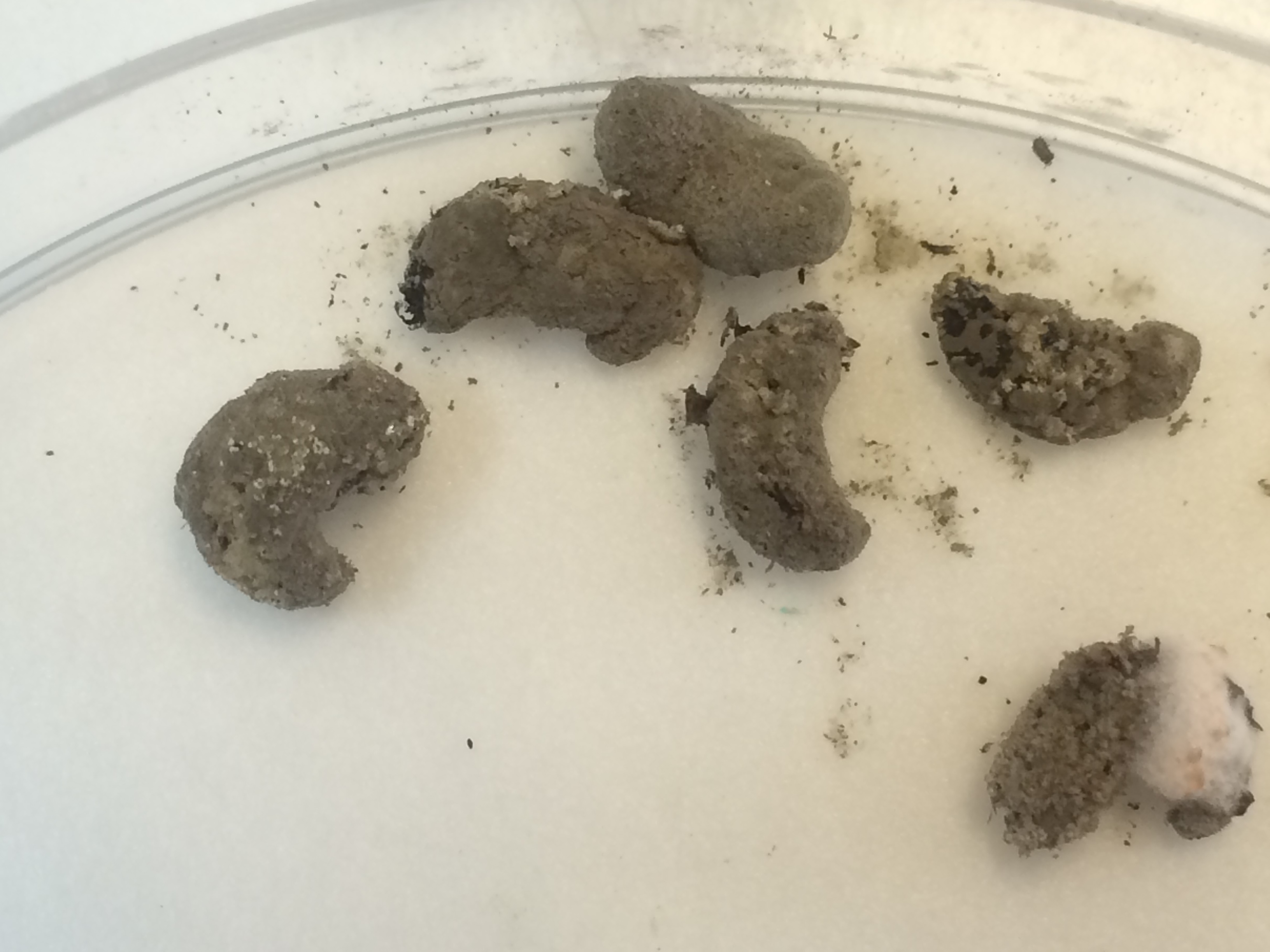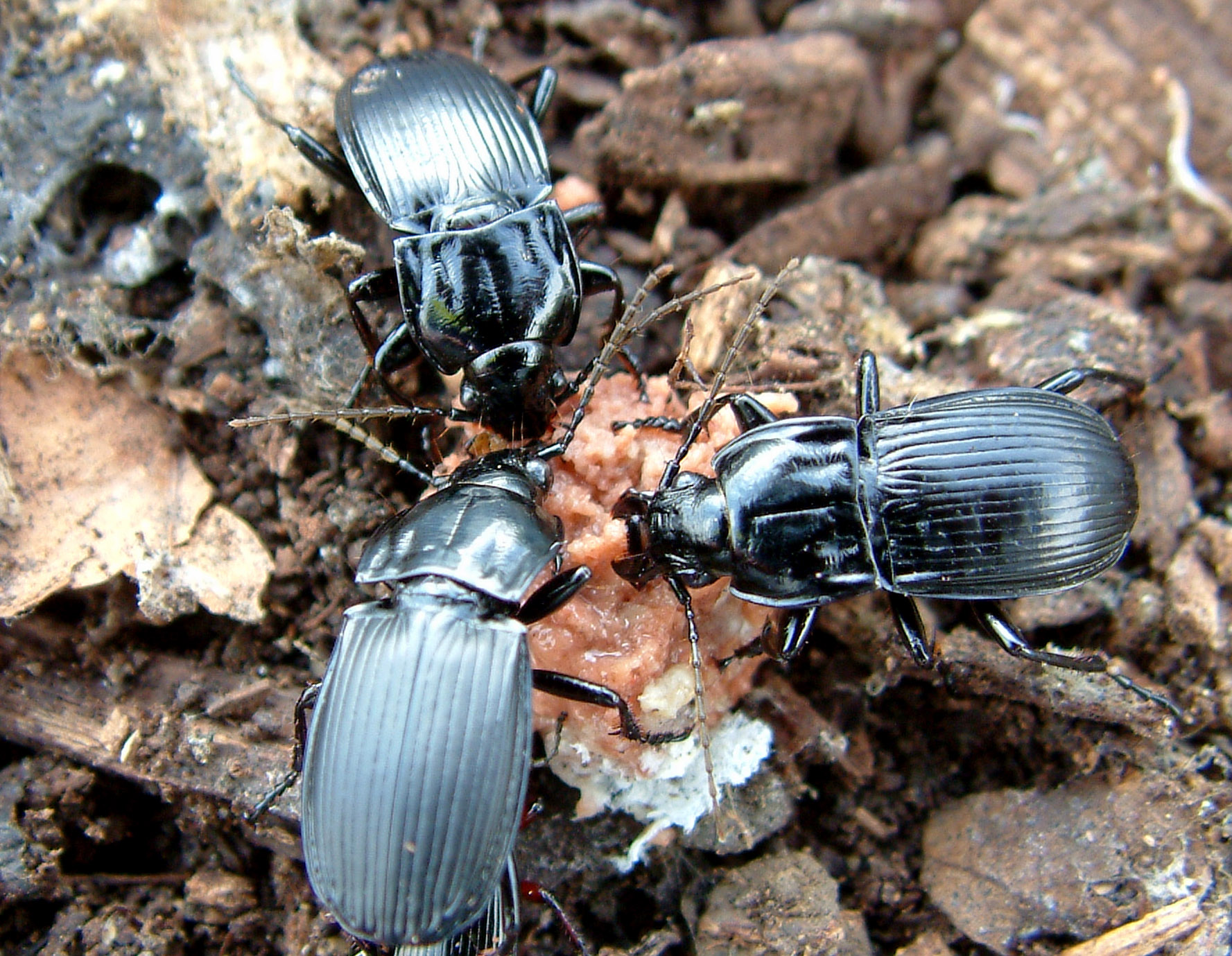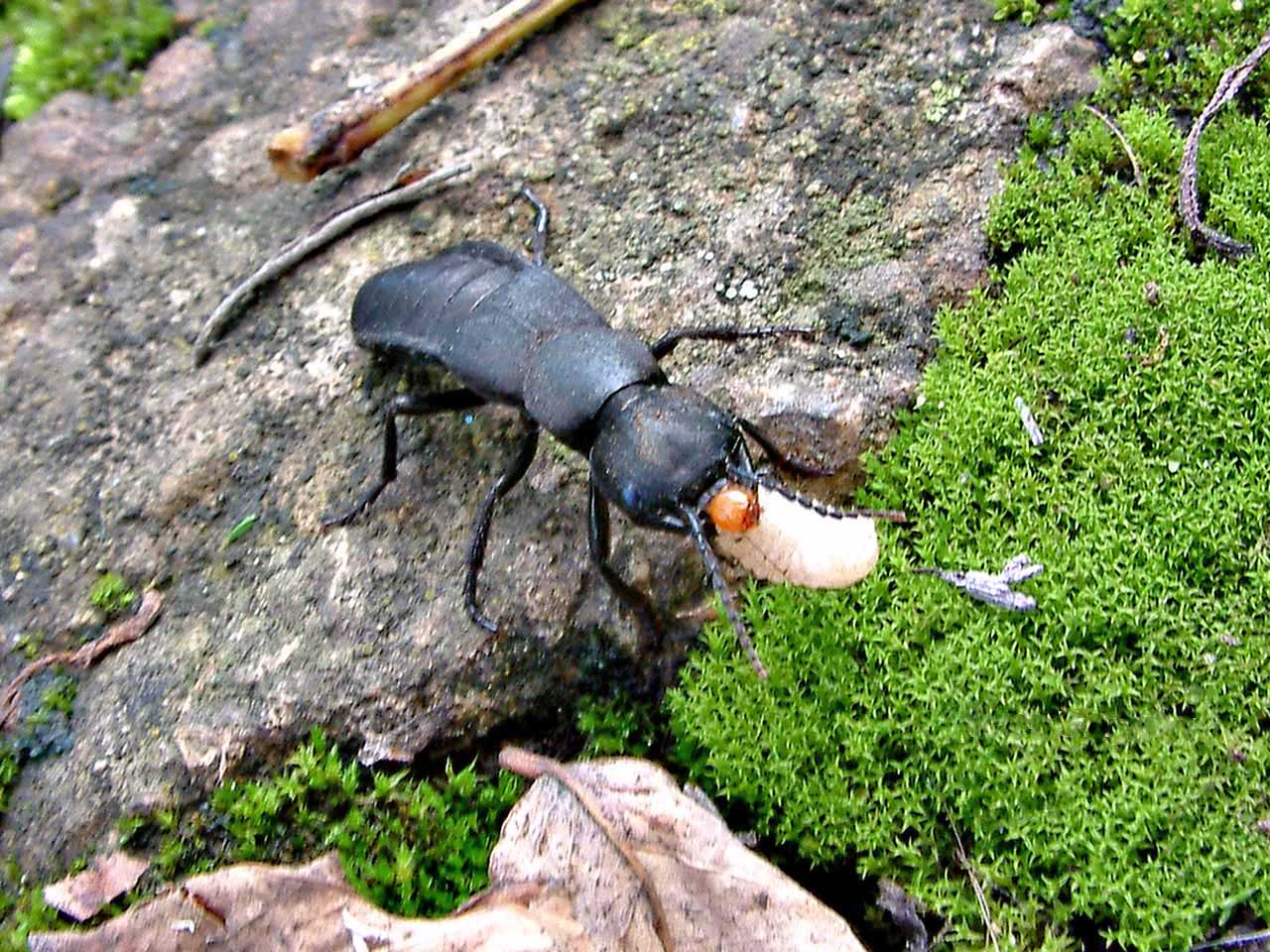Please click here to access the main AHDB website and other sectors.
- Home
- Knowledge library
- Vine weevil in soft fruit: Biological control – fungi and natural predators
Vine weevil in soft fruit: Biological control – fungi and natural predators
Find details about the one fungus and the variety of predators that can help to control outbreaks of vine weevil.
This information was last updated in 2018.
Please read the disclaimer at the bottom of this page
Go back to the main page: Vine weevil control in soft fruit
Entomopathogenic fungi
There is only one entomopathogenic fungus species currently approved for vine weevil control in the UK, Metarhizium anisopliae (now renamed M. brunneum), which is sold as Met52 Granular Bioinsecticide (see Table 1). This is a granular product formulated on rice grains that have the characteristic green colour of the Metarhizium spores.
|
Product name (examples) |
Active ingredient and IRAC code |
Insecticide group |
Approval status for soft fruit crops |
Application method |
Compatibility with biological control agents used against other pests |
Comments |
|
Biopesticides recommended for control of vine weevil larvae |
||||||
|
Met52 |
Metarhizium anisopliae (now renamed M. brunneum) |
Entomopathogenic fungus |
On-label for protected and outdoor blackberry, blackcurrant, blueberry, gooseberry, raspberry, redcurrant, strawberry & whitecurrant |
Growing media or soil incorporation pre-planting in spring |
Safe to entomopathogenic nematodes. May reduce survival of other biological controls with a ground-dwelling life stage e.g. Aphidoletes, Dalotia (Atheta). |
Needs 15-30°C when vine weevil larvae present |
|
Met52 |
Metarhizium brunneum (now renamed M. brunneum) |
Entomopathogenic fungus |
EAMU (1997/2011) |
Mulch on container-grown top fruit and on established plants in blueberry, bilberry, cranberry, Ribes hybrids, Rubus hybrids, Logan berry, table and wine grape crops. |
Safe to entomopathogenic nematodes. May reduce survival of other biological controls with a ground-dwelling life stage e.g. Aphidoletes, Dalotia (Atheta). |
For control of vine weevil larvae in container-grown top fruit. For control of leatherjackets and midges with a ground-dwelling pupal stage in the named soft fruit crops but may give incidental control of vine weevil larvae. Needs 15-30°C when vine weevil larvae present. |
Table 1. Currently approved plant protection products that are either recommended for vine weevil control or will give some incidental control when used for control of other pests in soft fruit (correct as of September 2017). Please check the latest regulations before use.
Met52 can be bought pre-mixed in growing media (mainly for use in hardy nursery stock and not available pre-mixed in coir) or as the product for growers to incorporate into substrate or soil before planting any soft fruit crop both under protection and outdoors.
During mixing, fungal spores break off the rice grains and become distributed through the growing media or soil. When vine weevil larvae come into contact with them, the spores germinate on their cuticles and the fungus grows inside their bodies and kills them. Young infected larvae decay rapidly after death but older infected larvae can be found in the growing media or soil and can be recognised by the fungal growth on their bodies which is white at first but then turns greyish-green (see figure 1).
Met52-treated growing media can also be used as a mulch on certain soft fruit crops ( for detail, see Table 1).
 Warwick Crop Centre
Warwick Crop Centre
Figure 1. Vine weevil larvae infected with Met52 turn a grey-green colour.
Environmental requirements of Met52
- Met52 is most effective at temperatures between 15 and 30°C.
- Below 15°C the fungus works more slowly and it does not work below 10°C, although the spores will remain viable even down to minus 18°C.
- The spores will be killed at temperatures above 40°C.
- Treated growing media should be stored in a cool shady place, away from direct sunlight and at temperatures below 30°C.
- Met52 can be used in all types of growing media but use in heavy soil types will reduce efficacy.
- The growing media or soil should not be too wet or too dry.
Application methods, timing and persistence
It is not practical to mix Met52 into coir blocks.
If using Met52 in other growing media it should be used throughout the production cycle (i.e. when potting on into larger pots or planting into bags or containers, the fresh growing media should also be treated). The product should be thoroughly incorporated into growing media using the recommended rate and using clean mixing equipment free from pesticide residues. Once mixed, the growing media should be used within 30 days.
Temperature requirements
When applied by broadcasting to field soil immediately before planting in the spring it should be incorporated into the top 5cm. Met52 should not be applied to soil before autumn planting due to its temperature requirements.
Met52 can also be applied as a mulch on container-grown top fruit for the control of vine weevil larvae and on blueberry, bilberry, cranberry, Ribes hybrids, Rubus hybrids, Loganberry and table/wine grapes for the control of the ground-dwelling life stages of leatherjackets and midges, when it can give some incidental control of vine weevil.
Apply as a 5cm mulch in late spring, before adult vine weevils lay their eggs, in order to target larvae hatching from eggs laid into the mulch. Keep the mulch moist to optimise control. The product should be applied before vine weevil egg laying occurs, not as a curative treatment.
Met52 is likely to persist in treated growing media or soil for a year, but will only infect vine weevil larvae in favourable conditions. For example, the product will stop working when temperatures become too cool in the autumn, but it will become active again once temperatures rise in the spring. Therefore, larvae could become infected with spores in the autumn, but they will not die until the spring, by which time plant damage may already have occurred.
Persistence
If used pre-planting, Met52 will not give control of vine weevil after the first year’s cropping in any soft fruit crops grown for subsequent years.
The effect of typical fluctuating temperatures on Met52 efficacy is not well understood.
This was investigated in hardy nursery stock in the AHDB Horticulture-funded project HNS 195.
Monitoring for Met52 efficacy
- Check for live and dead vine weevil larvae in the growing media from April to September and look for symptoms of Met52 infection.
- Presence and efficacy of Met52 in treated growing media can be checked by using fresh mealworms in a simple test. Guidelines are available from Fargro.
Use within an IPM programme
- Met52 should not be relied upon as the sole method for vine weevil control, but should be used as part of an IPM programme for vine weevil management.
- If using in strawberry, use together with nematode application as vine weevil larvae can burrow into the fleshy crowns where they will be protected from Met52 spores in the substrate or soil.
- Monitor all treated crops regularly for weevil larvae, particularly when soil or growing media temperatures drop below 15°C in the autumn and apply a curative drench of nematodes if required, selecting a nematode species and product according to temperature (Table 1).
- As Met52 is a fungus it could be adversely affected by some fungicides used as drenches to the growing media.
- Check the supplier’s recommendations.
Further work on the side effects of fungicides on Met52 has been done in AHDB Horticulture-funded project HNS 195.
Natural predators
Naturally-occurring predatory carabid (ground) beetles and staphylinid (rove) beetles commonly occur in soft fruit fields.
 Roger Umpelby
Roger Umpelby
Figure 2. Carabid beetle adults feeding.
In AHDB-funded project SF 15b, gut analysis using a monoclonal antibody technique confirmed that both groups of beetles had predated vine weevil eggs, larvae or adults in strawberry and blackcurrant plantations.
Other invertebrate natural enemies of vine weevil include ants, earwigs and both predatory and parasitic wasps.
Avoiding the use of broad-spectrum plant protection products will help these natural beetle populations to survive and contribute to vine weevil control.
- Shrews, hedgehogs and various birds will also predate vine weevils.
- Song Thrush and Skylark will both consume weevils but are not widespread.
- Pheasant and partridge are more common and can be useful as they tend to scratch and peck around the base of plants where the adults are found.
- Wild birds can be encouraged by local hedgerow management and natural and artificial refuges can be provided for hedgehogs.
 Roger Umpelby
Roger Umpelby
Figure 3. Devil’s coachhorse with vine weevil larva.
Commercially available beetles
Defra-funded research (project PS2130) demonstrated that the commercially-available rove beetle, Atheta (now renamed Dalotia coriaria) that is used in some protected edible and ornamental crops for control of sciarid and shore fly eggs and larvae, will also predate young vine weevil larvae.
Subsequent research at Harper Adams University showed that Dalotia coriaria will also eat newly-laid vine weevil eggs and that they are compatible with Met52 over a 30-day period.
Further research would be needed to investigate the potential of Dalotia against vine weevil before it could be recommended to growers.
Useful links
Vine weevil in soft fruit: Biology and plant damage
Vine weevil in soft fruit: Effects of crop type and production system
Vine weevil in soft fruit: Sources of infestation, behaviour and monitoring
Vine weevil in soft fruit: Cultural control
Vine weevil in soft fruit: Biological control – nematodes
Vine weevil in soft fruit: Biological control – nematode application methods
Vine weevil in soft fruit: Chemical control
Biocontrol in Soft Fruit Guide
Download the original vine weevil control in soft fruit factsheet
Original author/s
Jude Bennison, Janet Allen & John Atwood, ADAS
Tom Pope, Harper Adams University
Disclaimer
Please note this information was last updated in 2018. Biocidal and plant protection products must only be used in accordance with the authorised conditions of use. Regular changes occur in the authorisation status of biocides and plant protection products. For the most up to date information, please check with your professional supplier, BASIS registered adviser or the Chemical Regulation Division (CRD) of HSE (https://www.hse.gov.uk/crd/) before use.
While the Agriculture and Horticulture Development Board seeks to ensure that the information outlined on this page is accurate at the time of publishing, no warranty is given in respect thereof and, to the maximum extent permitted by law the Agriculture and Horticulture Development Board accepts no liability for loss, damage or injury howsoever caused (including that caused by negligence) or suffered directly or indirectly in relation to information and opinions contained in or omitted from this information.
Topics:
Sectors:
Tags:

